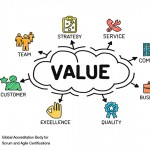Delivering maximum business value in a minimum time span is ingrained in the Scrum framework. Usually, Scrum projects are expected to create business or service value which makes Scrum framework attractive for business stakeholders.
But it is not clear if Business Value can be achieved by reducing costs involved, increasing the end revenue, enhancing customer delight, minimising risk or enhancing organizational capability. Business value and its assignment is a subjective task that requires balancing a lot of information based on lot of changing priorities. Product owner uses it as an indicator to prioritize the product backlog. Product backlog prioritization includes many other variables and attributes. Therefore, prioritization based on business value should not be the only approach. A good product owner should have strong understanding of the product’s vision and a good rapport with the customer and development team. Product owner should also take calculation of risk and effort into account while prioritizing backlogs. Product Owner should be able to forecast positive business value (gained after product is delivered) and negative business value (that can bring down the revenue figures) based on risk.
Companies in fact differ in their sales processes that determine what potential value of a product feature to launch in the market and the right time when to ship the product in the market. Stakeholders and senior management in a company decide on what to be shipped next to earn value. However, Stakeholders impose their individual wishes on the development teams or the Product Owners as their priorities do not match. A common agreement between the Stakeholders is achieved in respect to the fact, that the Product Owner should be the overall in charge of defining priorities.
Business Values are estimated in the same way the developers estimate the complexity. Estimation poker helps Product Owners and Stakeholders to get together, to share information related to Business Values and come up with an agreement. It brings understanding and respect among them and team members.
The practice of estimating business value on each story faces some problems like assigning a discrete value on small features or bits of functionality and determining the cost of the feature. However, that does not mean that we should not do ROI analysis of user stories or put business value to features .During such analysis and estimation a balance should be maintained between value and the cost associated. It is best done at the level of large user stories.










Good overview and well explained…